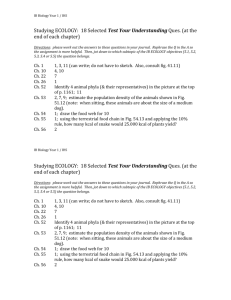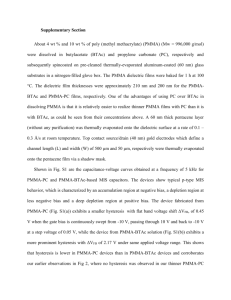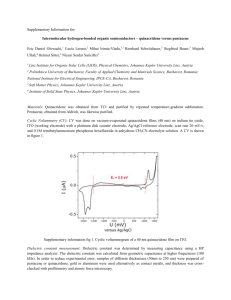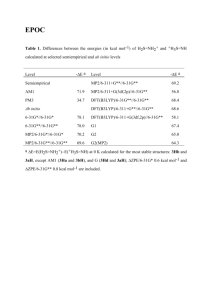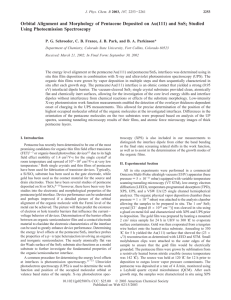A12. 05. 0238_Supplementary Materials_corrected
advertisement
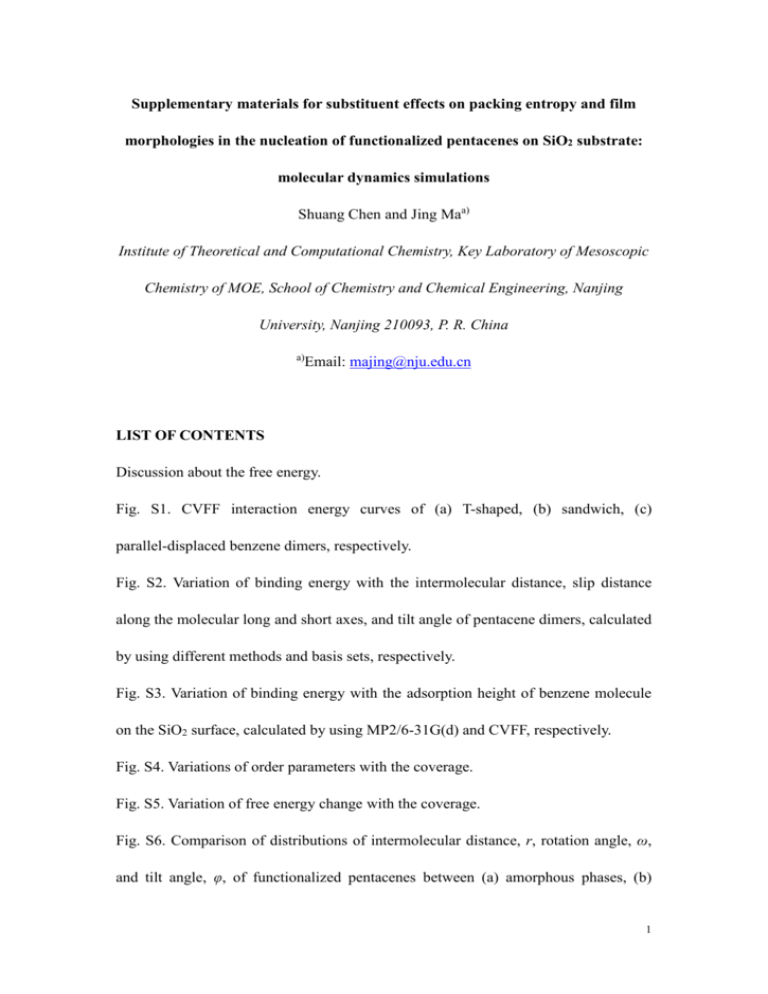
Supplementary materials for substituent effects on packing entropy and film morphologies in the nucleation of functionalized pentacenes on SiO2 substrate: molecular dynamics simulations Shuang Chen and Jing Maa) Institute of Theoretical and Computational Chemistry, Key Laboratory of Mesoscopic Chemistry of MOE, School of Chemistry and Chemical Engineering, Nanjing University, Nanjing 210093, P. R. China a) Email: majing@nju.edu.cn LIST OF CONTENTS Discussion about the free energy. Fig. S1. CVFF interaction energy curves of (a) T-shaped, (b) sandwich, (c) parallel-displaced benzene dimers, respectively. Fig. S2. Variation of binding energy with the intermolecular distance, slip distance along the molecular long and short axes, and tilt angle of pentacene dimers, calculated by using different methods and basis sets, respectively. Fig. S3. Variation of binding energy with the adsorption height of benzene molecule on the SiO2 surface, calculated by using MP2/6-31G(d) and CVFF, respectively. Fig. S4. Variations of order parameters with the coverage. Fig. S5. Variation of free energy change with the coverage. Fig. S6. Comparison of distributions of intermolecular distance, r, rotation angle, ω, and tilt angle, φ, of functionalized pentacenes between (a) amorphous phases, (b) 1 monolayers on the SiO2 surface, and (c) crystals. 2 Discussion about the free energy During the nucleation, the free energy of the studied system, including the deposited molecules and substrate, can be approximately traced as after adding the 1st molecule: F1 U M VMS US VS (1) involving the average kinetic energy of one molecule, UM, the average potential energy from the interaction between one molecule and substrate, VMS, the average kinetic energy of substrate, US, and the average potential energy of substrate, VS; 2 after adding the 2nd molecule: F2 2U M 2VMS C22VMM US VS TSpack (2) where VMM is the average potential energy from the interaction between two molecules, and Spack is the packing entropy; 3 after adding the 3rd molecule: F3 3U M 3VMS C32VMM US VS TSpack (3); ······ after adding the (N-1)th molecule: N 1 FN 1 N 1U M N 1VMS CN2 1VMM US VS TSpack N after adding the Nth molecule: FN NU M NVMS CN2 VMM US VS TSpack (4); (5). According to these equations, the change in free energy is expressed as follows F N N 1 FN FN 1 U M VMS N 1VMM T S pack S pack N (6). As the equations presented here, the free energy would increase with the molecule deposited, but it is not proportional to the number of the deposited molecules, N, on the substrate. There are some “jumps” in the free energy landscape, because the VMM and VMS terms are quite sensitive to the molecular orientations. 3 (a) T-shaped 20 10 r 0 -10 4.0 CVFF 4.5 5.0 5.5 6.0 r (Å) 6.5 7.0 7.5 8.0 (b) Sandwich 10 r 5 0 -5 3.0 CVFF 3.5 4.0 4.5 5.0 r (Å) 5.5 6.0 6.5 Interaction Energy (kcal/mol) 30 7 15 Interaction Energy (kcal/mol) Interaction Energy (kcal/mol) 40 6 (c) Parallel-displaced 5 4 3 r = 3.2 Å 2 d 1 CVFF 0 -2.0 -1.5 -1.0 -0.5 0.0 0.5 1.0 1.5 2.0 d (Å) FIG. S1. CVFF interaction energy curves of (a) T-shaped, (b) sandwich, (c) parallel-displaced benzene dimers, respectively. 4 Binding Energy (kcal/mol) 20 (a) (b) r dx dy (c) (d) φ 0 -20 CVFF MP2/6-31G(d) MP2/6-31G(d, p) MP2/6-31+G(d) -40 3.0 3.5 4.0 4.5 5.0 0.0 Intermolecular Distance, r (Å) 0.4 0.8 1.2 1.6 Slip Distance along x direction, dx (Å) 2.0 0.0 0.4 0.8 1.2 1.6 Slip Distance along y direction (Å) 2.0 0 20 40 60 80 100 Tilt Angle, (°) FIG. S2. Variation of binding energy with (a) the intermolecular distance, r, (b) slip distance along the molecule long axis, dx, (r = 3.5 Å), (c) slip distance along the molecular short axis, dy, (r = 3.5 Å), and (d) tilt angle, φ, (r = 5.0 Å) of pentacene dimers, calculated by using MP2 with different basis sets and CVFF, respectively. The influence of basis sets (6-31G(d), 6-31G(d, p), and 6-31+G(d)) on interlayer translation of pentacene dimer is highlighted in (a). 5 Binding Energy (kcal/mol) 20 MP2/6-31G(d) CVFF 0 Pn -20 Benzene Simplified H H SiO2 Cluster model Si14O22H24 -40 2.5 3.0 3.5 4.0 4.5 5.0 Adsorption Height, H (Å) FIG. S3. Variation of binding energy with the adsorption height, H, of benzene molecule on the SiO2 surface, calculated by using MP2/6-31G(d) and CVFF, respectively. The simplified model is also illustrated in insets. 6 rM Radial: Qr 0 Order Parameters, Q Order Parameters, Q 1.0 Orientational t-Bu Pn TIPS Pn Trajectory 1 0.5 0.0 2D -0.5 Order Parameters, Q Order Parameters, Q Pn 1 3cos2 1 g ( )d 2 1 Q 3cos 2 1 g ( )d 2 Q 2 1 r 3 1 g (r )dr 2 rM 1.0 0.5 0.0 1D -0.5 0.0 0.2 0.4 0.6 0.8 1.0 Coverage, (ML) 1.0 Trajectory 2 0.5 0.0 -0.5 1.0 Trajectory 3 0.5 0.0 Qr Q -0.5 rM = 5.5 Å 0.0 0.2 0.4 rM = 6.5 Å 0.6 0.8 Coverage, (ML) 1.0 0.0 0.2 0.4 Q rM = 8.5 Å 0.6 0.8 Coverage, (ML) 1.0 0.0 0.2 0.4 0.6 0.8 1.0 Coverage, (ML) FIG. S4. Variations of radial (Qr) and orientational (Qω and Qφ) order parameters with the coverage during the nucleation processes of functionalized pentacene molecules for three independent MD simulations. 7 Pn Trajectory 2 Trajectory 1 240 Trajectory 3 (kcal/mol) 1D 200 160 t-Bu Pn 1D growth 2D gorwth 2D 120 (kcal/mol) 240 200 160 F FN FN 1 N 120 TIPS Pn A A (kcal/mol) 3000 1500 0 0.0 0.2 0.4 0.6 0.8 Coverage, (ML) 1.0 0.0 0.4 0.2 0.6 0.8 Coverage, (ML) FIG. S5. Variation of free energy changes, 1.0 0.0 0.2 0.4 0.6 0.8 1.0 Coverage, (ML) F FN FN 1 , between two successive N adding steps, involving with the Nth and (N-1)th incoming functionalized pentacene molecules, with the coverage for three independent MD simulations. The 400 ps-snapshot of standing TIPS pentacene on the SiO2 surface is also highlighted in the inset ○ A. 8 (a) Amorphous solids 0.09 g 0.06 0.03 0.00 0.09 (b) Monolayers g 0.06 0.03 0.00 i 0.9 (c) Crystals i j r j 0.0 φ ω 0.3 0 6 12 18 Intermolecular Distance, r (Å) 0 20 Pn t-Bu Pn TIPS Pn j g 0.6 i 40 60 Rotation Angle, (°) 80 0 20 40 60 80 Tilt Angle, (°) FIG. S6. Comparison of distributions of intermolecular distance, r, rotation angle, ω, and tilt angle, φ, of pentacene, t-Bu pentacene, and TIPS pentacene between (a) amorphous solids, (b) monolayers on the SiO2 surface, and (c) crystals. 9

